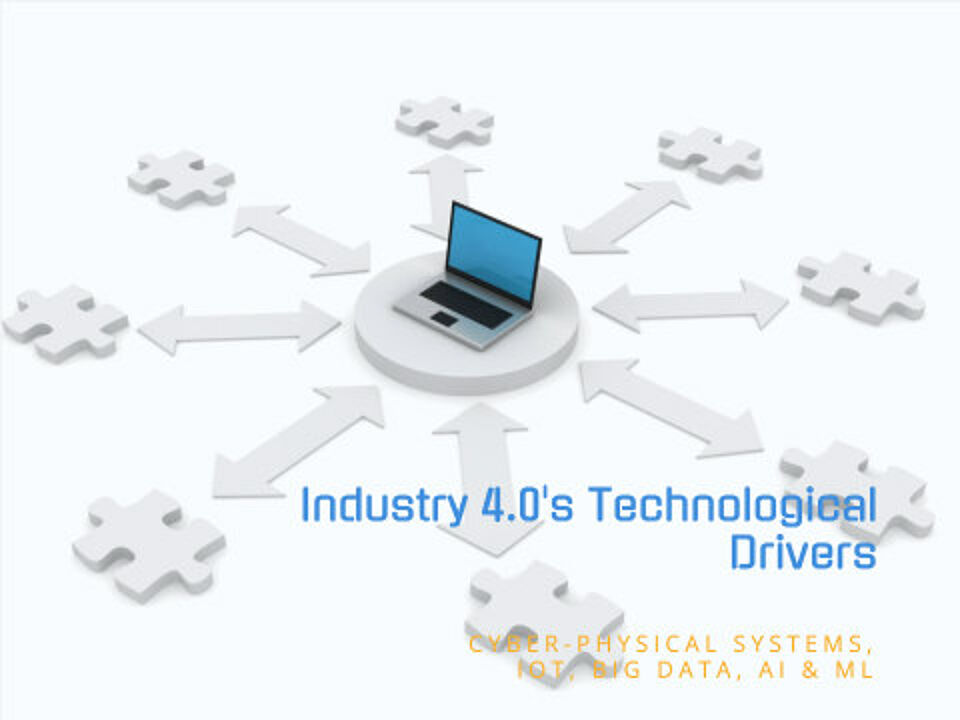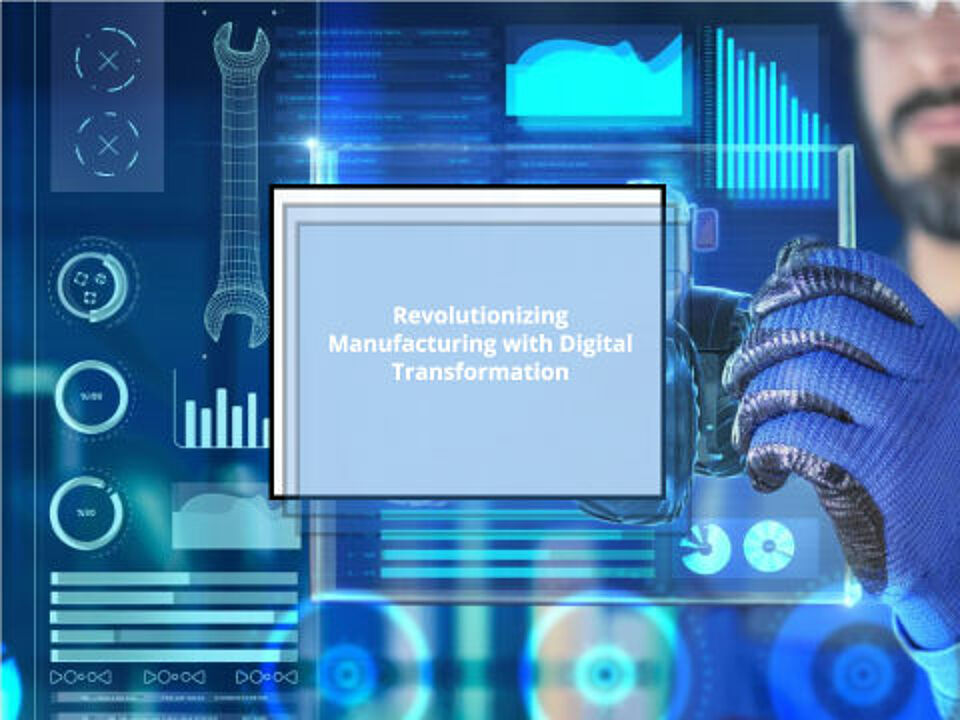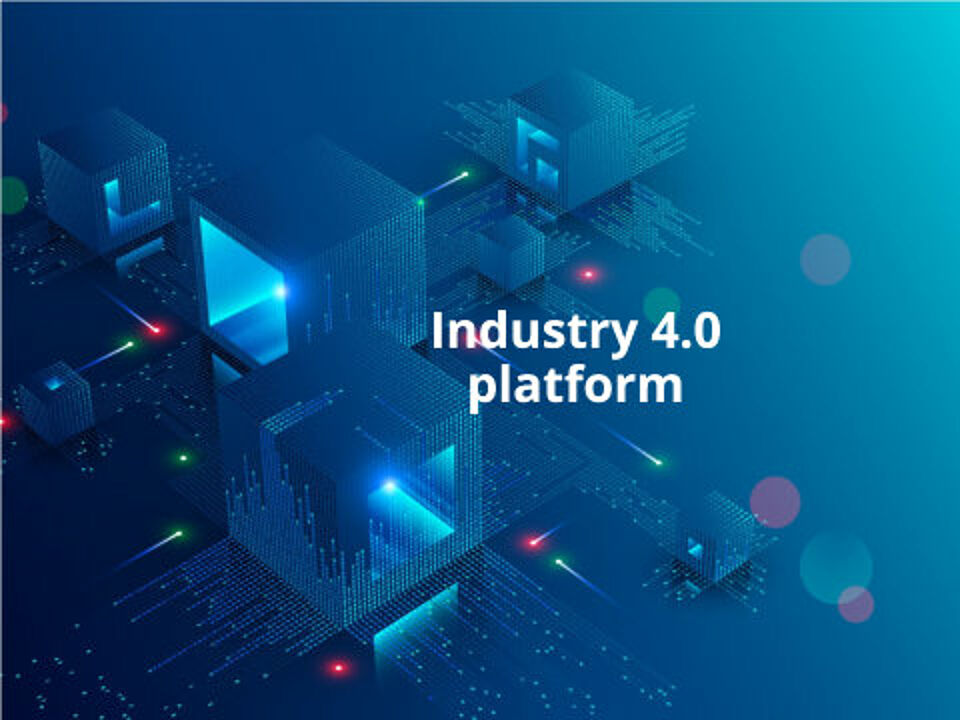
Definition and origin
Author: Jochen Möller (CEO and CoFounder EcholoN) - Creation: 26.06.2022, last change: 18.10.2024
Table of contents
Technological drivers of Industry 4.0
Digital transformation in manufacturing
Robotics and automation
Human-machine interaction
Industry 4.0 platform
The term "Industry 4.0" refers to the fourth industrial revolution, which is characterised by the digitalisation and networking of production processes. The term was first introduced in 2011 as a high-tech strategy at the Hannover Messe trade fair in Germany and aims to revolutionise the manufacturing industry through the use of modern information and communication technologies. At the heart of Industry 4.0 and the factory of tomorrow is the vision of a smart factory in which cyber-physical systems (CPS), the Internet of Things (IoT), cloud computing and cognitive technologies work together seamlessly to enable highly flexible, efficient and automated production in networked factories.
The evolution of industrial revolutions: From 1.0 to 4.0
The history of industrial revolutions begins in the 18th century with the introduction of mechanical production facilities driven by water and steam power (Industry 1.0). The transition to Industry 2.0 was marked by the introduction of mass production, characterised by assembly line work and the use of electrical energy, in the early 20th century. The third industrial revolution, or Industry 3.0, began in the 1970s with the automation of production through the use of electronics and information technology. Industry 4.0 builds on these developments, focussing on the integration of digital technologies into manufacturing processes to achieve unprecedented flexibility and efficiency.
The key components of digitalisation and Industry 4.0
The key components of Industry 4.0 digitalisation include a range of technologies and concepts that together form the basis for digital transformation in the manufacturing industry:
- Cyber-Physical Systems (CPS): these systems connect physical objects and processes with the digital world. Sensors and actuators enable machines and systems to collect, analyse and react to data in real time.
- Internet of Things: The IoT enables the intelligent networking of machines, workpieces and systems via the internet, enabling comprehensive data collection and utilisation along the entire value chain.
- Big data and analytics: The analysis of large volumes of data enables companies to optimise processes, make predictions and develop personalised offers.
- Cloud computing: By utilising cloud services, companies can achieve scalability, flexibility and efficiency in their IT infrastructure.
- Artificial intelligence (AI) and machine learning (ML): These technologies support the automation of complex processes and the optimisation of decision-making.
Together, these components provide the technological foundation for Industry 4.0 and enable a new era of digital and networked production with the cross-company digitalisation of supply chains.

Technological drivers of Industry 4.0
Internet of Things (IoT) and its role
The Internet of Things is a key technology in Industry 4.0 that makes it possible to connect machines, devices, components, sensors and people via the internet. This networking allows data to be exchanged in real time, creating a basis for the automation and optimisation of production processes. IoT devices collect valuable data about the condition of machines, the progress of production processes and the environment in which they operate. This information enables precise monitoring and control of production, resulting in increased efficiency, lower operating costs and improved product quality.
Cyber-physical systems (CPS)
Cyber-physical systems are integrated networks of physical components and computerised algorithms. They are at the heart of Industry 4.0 as they connect the physical and digital worlds. CPS use sensors and actuators to collect data from the physical world, which is then analysed and interpreted by the software. These analyses lead to decisions, which in turn are translated into physical actions via actuators. CPS thus enable intelligent and autonomous control of machines and systems, leading to self-optimising production.
Big data and analytics
In Industry 4.0, IoT devices and CPS generate an enormous amount of data, known as big data. Analysing this data plays a crucial role as it provides insights into production processes that were previously not possible. Big data and analytics enable companies to identify patterns and trends in this data, leading to the optimisation of operations, the prediction of maintenance needs and the personalisation of customer offers. By using advanced analytics techniques, companies can increase their efficiency while improving the quality of their products and services.
Cloud computing and edge computing
Cloud computing offers companies the opportunity to utilise computing resources and data storage on demand via the internet, resulting in flexibility, scalability and cost efficiency. In the context of Industry 4.0, the cloud enables the centralised management of data and applications required to control production processes. Edge computing complements cloud computing by performing data processing tasks closer to the data source, i.e. directly on machines and systems. This reduces latency times and bandwidth requirements and enables real-time reactions to events in production.
Artificial intelligence (AI) and machine learning (ML)
AI and ML are essential technologies for the realisation of Industry 4.0. They enable machines to learn from data, recognise patterns and make independent decisions. In production, AI systems can be used for quality control by identifying product defects faster and more accurately than human inspectors. ML algorithms optimise production processes by continuously learning from process data and making adjustments to maximise efficiency and yield. The integration of AI and ML in Industry 4.0 leads to smarter, self-optimising production systems that enable higher productivity and flexibility.

Digital transformation in manufacturing
Smart Factory: features and benefits
The smart factory is at the centre of the digital transformation in manufacturing. It is a state-of-the-art production facility that integrates digital technologies and automated systems to enable flexible, efficient and intelligent production. The core features of a smart factory include the networking of machines and systems via the Internet of Things (IoT), the use of cyber-physical systems (CPS) to monitor and control production processes and the use of AI and machine learning for process optimisation. The benefits of a smart factory are manifold and include improved productivity through more efficient processes, greater flexibility in adapting products to customer requirements, reduced downtime through preventive maintenance and an overall increase in product quality. Digitalisation also allows companies to collect and analyse real-time data about their production processes, which enables continuous improvement.
Digital twins and their application
Digital twins are virtual images of physical objects or systems that are synchronised with them in real time. They use data from various sources, including IoT sensors, to create a detailed, digital model that can simulate the behaviour and performance of its physical counterpart. In manufacturing, digital twins enable the simulation, analysis and optimisation of production processes even before physical changes are made. This leads to significant savings in time and costs and minimises the risk of errors. In addition, digital twins can be used for preventive maintenance by monitoring the condition of machines and systems in real time and predicting when maintenance work is required before failures occur.
Additive manufacturing (3D printing)
Additive manufacturing, better known as 3D printing, is a revolutionary technology that is fundamentally changing the way products are designed, manufactured and distributed. In contrast to traditional, subtractive manufacturing, where material is removed to mould a product, 3D printing builds objects layer by layer, enabling a high degree of design flexibility and the production of complex structures that would be impossible or difficult to manufacture using conventional methods. Especially in prototype construction, this type of manufacturing is an adequate business model and value-added process with a wide range. Additive manufacturing offers numerous advantages, including the reduction of material waste, the ability to personalise products, faster prototype development and the ability to realise on-demand production. This technology supports the digital transformation in manufacturing by increasing efficiency, reducing time to market and opening up new opportunities for innovation in product design and manufacturing.
Communication and networking
Industrial Internet of Things (IIoT)
The Industrial Internet of Things is an extension of the IoT, specifically tailored to the requirements of industry. IIoT connects machines, systems, sensors and people in industrial environments to collect, transmit and analyse data in real time. This connectivity enables improved monitoring and automation of production processes, resulting in increased efficiency, productivity and flexibility. IIoT systems use advanced analytics and AI to gain insights from the collected data to help optimise operations, perform preventive maintenance and improve decision-making. Implementing IIoT solutions enables companies to make their production processes smarter and more dynamic, giving them a significant competitive advantage.
Wireless communication technologies and standards
In modern Industry 4.0, wireless communication plays a crucial role in the networking of devices and systems. Various wireless technologies, such as Wi-Fi, Bluetooth, Zigbee and LTE/5G, offer different ranges, transmission speeds and energy efficiency to meet the diverse requirements of industrial applications. In particular, 5G networks, with their high speed, low latency and ability to connect a large number of devices, are seen as paving the way for real-time data transmission and analysis in Industry 4.0. The choice of the right technology depends on specific requirements such as transmission range, data rate and energy consumption. Standards also play an important role, as they ensure interoperability between devices from different manufacturers and thus enable seamless communication within the industrial ecosystem.
Data, information and IT security
With the increasing networking of devices and systems in Industry 4.0, the importance of data, information and IT security is also growing. Although the collection and analysis of data in real time opens up enormous opportunities for optimising production processes, it also harbours risks in terms of data protection and data security. Cyberattacks on industrial control systems can lead to operational disruptions, production downtime and even physical damage. It is therefore crucial to implement robust security measures that ensure the protection of sensitive data. These include encryption of data transmissions, regular security updates and patches for software and devices, the introduction of access controls and the training of employees in cyber security. A comprehensive security strategy is essential to protect the integrity and availability of systems and data in the networked industrial environment.

Robotics and automation
Collaborative robots (cobots)
Collaborative robots, also known as cobots, are designed to work directly alongside humans without the need for extensive safety measures. Unlike traditional industrial robots, which often operate in confined areas, cobots can recognise the presence of humans and adjust their movements accordingly thanks to advanced sensors and control technologies. This capability enables safe interaction and co-operation between humans and machines. Cobots are increasingly being used in various industrial sectors, from assembly to quality control and packaging, and offer numerous benefits, including flexibility, increased efficiency and relieving employees of repetitive or ergonomically unfavourable tasks. The introduction of cobots helps to increase productivity and improve working conditions at the same time.
Autonomous mobile robots (AMR) in logistics
Autonomous mobile robots are revolutionising the logistics industry by increasing flexibility and efficiency in warehouses and distribution centres. AMRs are able to navigate autonomously within their environment, avoid obstacles and perform tasks such as transporting goods, picking orders or carrying out inventories. These robots utilise a variety of technologies, including lidar, cameras and artificial intelligence, to move and operate safely. The use of AMRs enables companies to optimise their logistics processes, shorten throughput times and reduce the workload for staff. In addition, AMRs can be quickly adapted to changing requirements, making them a valuable tool for managing seasonal fluctuations and the growth of e-commerce.
Advances in robotics and their impact
Robotics has made significant advances in recent years, driven by innovations in areas such as AI, sensor technology and materials science. These advances have made it possible to develop robots that can perform more complex tasks, work in more dynamic environments and collaborate more closely with humans. The impact of these developments is diverse and far-reaching. In industry, they are leading to further automation of production processes, which increases efficiency and reduces manufacturing costs. At the same time, they open up new possibilities for personalising products and responding flexibly to market requirements. Furthermore, advances in robotics have the potential to change the world of work by creating new occupational fields and transforming existing jobs. While some activities are being automated, new needs for expertise in robotics and automation technology are emerging, increasing the demand for appropriately qualified personnel.

Human-machine interaction
Augmented reality (AR) and virtual reality (VR) in industry
Augmented reality and virtual reality are transformative technologies that are revolutionising the way people interact with machines and data in industry. AR overlays digital information in the real world, allowing workers, for example, to have instructions and important information displayed directly in their field of vision while working on machines. This can increase efficiency and reduce errors by providing instant access to data such as assembly instructions or maintenance notes. VR, on the other hand, creates a fully immersive environment that can be used for training and simulation. Employees can be trained in a risk-free virtual environment to learn complex procedures or simulate dangerous situations, increasing workplace safety and accelerating the learning curve.
Wearable technologies and their use
Wearable technologies, such as smartwatches, fitness trackers and smart glasses, are increasingly being used in industrial environments. These devices can help improve the efficiency and safety of work processes by providing real-time data on the wearer's condition (e.g. fatigue, heart rate) or enabling access to important information and notifications without having to interrupt work. In combination with AR, wearables can, for example, display technical drawings or maintenance information directly in the user's field of vision. This not only improves productivity, but can also contribute to health monitoring and accident prevention by sending out warnings in the event of potential hazards or overexertion.
Ergonomics and user-friendliness in the smart factory
The ergonomics and user-friendliness of workstations and machines are crucial for the efficiency and satisfaction of employees in the smart factory. An ergonomically designed workplace reduces physical strain and the risk of injury, which leads to greater job satisfaction and productivity. Modern user interfaces and interaction technologies, such as touchscreens, voice recognition and gesture-based control, help to make the operation of machines and systems more intuitive and efficient. Incorporating ergonomic principles into the design of human-machine interfaces supports fast and error-free interaction, which is particularly beneficial in complex industrial environments. The promotion of an ergonomic working environment and the development of user-friendly technologies are therefore key elements in the design of effective and sustainable production facilities.
Effects of Industry 4.0
On the world of work and qualification requirements
Industry 4.0 is fundamentally transforming the world of work and leading to a change in qualification requirements. Automation and digitalisation are not only replacing repetitive and manual activities, but are also creating new jobs that require a higher level of technical skills and digital expertise. The demand for IT experts, data analysts, robotics engineers and artificial intelligence specialists is increasing. At the same time, employees in more traditional roles must also be prepared to undergo further training and familiarise themselves with new technologies. Lifelong learning is becoming the norm as the half-life of expertise decreases. Companies and educational institutions must work together to prepare the workforce for these changes by offering appropriate training and retraining programmes.
On productivity and efficiency
The introduction of Industry 4.0 technologies has a significant impact on productivity and efficiency in production. By networking machines and automating processes, production sequences can be optimised and downtimes reduced. Predictive maintenance, made possible by analysing real-time data, helps to minimise downtimes, for example, by carrying out maintenance work exactly when it is needed. Flexible production is supported by the use of digital twins and additive manufacturing, which enable rapid customisation to customer wishes and market requirements. Overall, these technologies lead to an increase in production capacity while simultaneously reducing costs, which gives companies a decisive competitive advantage.
Sustainability and environmental aspects
Industry 4.0 offers considerable potential for making production more sustainable and environmentally friendly. The efficient utilisation of resources, for example through more precise control of production processes and the use of recycling and reprocessing technologies, can significantly reduce material waste and energy consumption. The improved efficiency also helps to reduce CO2 emissions. In addition, digitalisation enables better traceability of products and materials, which supports the implementation of circular economy concepts. By utilising big data and analytics, companies can also better understand and manage their environmental impact. Industry 4.0 therefore plays a key role in achieving sustainability goals and promoting environmentally conscious production.
Challenges and solutions
Data protection and data security
With increasing digitalisation in Industry 4.0, data protection and data security are becoming key challenges. The networking of machines and the collection of large amounts of data harbour risks in terms of data protection breaches and cyberattacks. Solutions include the implementation of robust IT security systems, encryption of data transmissions and regular security audits and training for employees. It is also important to create an awareness of cyber security at all levels of the organisation and to consistently apply data protection guidelines. Compliance with international standards and legal requirements on data protection also helps to build trust with customers and partners.
Standardisation and compatibility
Interoperability between different systems and technologies is another challenge on the road to Industry 4.0. A lack of standardisation and compatibility can lead to inefficiencies and increased costs. One solution is to promote industry-wide standards and support open interfaces that enable smooth communication and data transfer between devices from different manufacturers. Participation in consortia and standardisation bodies can help companies to influence the development of such standards while ensuring that their products and solutions remain compatible.
Skills shortages and training needs
The transition to Industry 4.0 and therefore also Work 4.0 requires a high level of specialised knowledge and skills, which is leading to a shortage of skilled workers in many places, especially in small and medium-sized companies. Comprehensive education and training programmes are needed to close this gap. SMEs can work in partnership with educational institutions to develop bespoke training programmes tailored to the specific requirements of Industry 4.0. Promoting STEM (Science, Technology, Engineering, Mathematics) subjects in schools and emphasising the importance of lifelong learning are other important steps. In addition, internal training programmes and the opportunity to gain hands-on experience with new technologies can help to upskill existing employees and equip them for the challenges of digital transformation.

Platform Industry 4.0
The Industrie 4.0 platform is a central initiative that aims to drive forward the digital transformation of industrial production. It acts as an ecosystem in which companies, scientific institutions, industry associations and political actors work together to promote the development and implementation of Industry 4.0 technologies. The platform serves as an information and exchange platform that provides resources, best practices, guidelines and standards to support companies in the introduction of Industry 4.0. A key objective is to strengthen the competitiveness of industry, accelerate innovation and promote sustainable growth.
Key aspects and aim of the Industry 4.0 platform
- Networking and exchange: The platform offers a unique opportunity for cross-industry exchange and collaboration between different stakeholders. This promotes the development of common standards and norms, which are essential for the successful implementation of Industry 4.0.
- Promotion of innovation: By bringing together expertise from industry, science and politics, innovative solutions and technologies are developed that form the basis for the digital transformation of production.
- Education and training: Another focus is on the development of education and training programmes to meet the demand for skilled workers and provide employees with the skills they need to work in a digitalised industry.
- International cooperation: The platform emphasises the importance of international cooperation in order to set global standards and learn from best practices worldwide. This not only strengthens the position of its own industry in international competition, but also promotes the global harmonisation of Industry 4.0 solutions.
Significance for the future
The Industry 4.0 platform plays a decisive role in shaping the future of industrial production. By pooling resources and knowledge, it helps to overcome the challenges of digital transformation and fully utilise the potential of Industry 4.0. It enables companies of all sizes to benefit from the advantages of the fourth industrial revolution by providing access to innovative technologies, expertise and a broad network. The platform thus makes a significant contribution to securing competitiveness and promoting sustainable industrial growth.
Conclusion
Summary of the key points
Industry 4.0 marks a revolutionary change in the way products are manufactured, processes are controlled and value chains are organised. At the heart of this transformation are the integration of cyber-physical systems, the Internet of Things, cloud computing, big data and analytics, as well as advanced technologies such as artificial intelligence, augmented and virtual reality. These technologies enable unprecedented networking of machines, systems and people, which leads to a significant increase in efficiency, flexibility and quality in production. Data protection, data security, standardisation and the shortage of skilled workers pose challenges, but these can be addressed with targeted measures and strategies. Successful implementations in various sectors demonstrate the broad range of applications and the potential of Industry 4.0.
The importance of Industry 4.0 for the future of manufacturing
Industry 4.0 is not just a short-term trend, but rather a fundamental building block for the future of manufacturing. It enables companies to adapt to rapidly changing market requirements, fulfil individual customer wishes efficiently and operate sustainably. Advancing digitalisation and automation are opening up new opportunities for innovations and business models based on intelligent, networked and data-driven production. Industry 4.0 makes a decisive contribution to securing the competitiveness of companies and creating new jobs that require higher qualifications. It also plays a key role in the realisation of sustainable production and the transition to a circular economy. Adapting to this fourth industrial revolution is therefore essential for the long-term success and sustainability of the global manufacturing industry.
See also
Maintenance software for reliable processes - EcholoN CMMS
- Blog article: Internet of Things - IoT
- Blog article: What is M2M? - Machine to Machine - Communication
- Blog article: The MQTT protocol in the IoT - Message Queuing Telemetry Transport
- Blog article: What is Data Integration (DI)? - Meaning of ETL - Tools
- RFID for Smart Equipment
